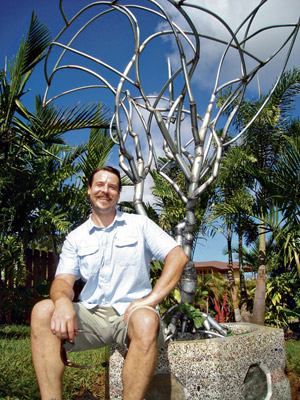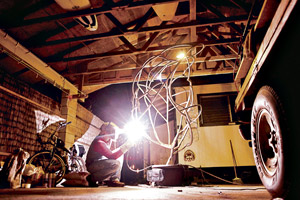Landscape Architecture With Flair

Ron Rovetto with his most recent installation at a private residence in Kapaa – a metal tree incorporated into a garden pond surrounded by plants. Coco Zickos photo
His most recent installation at a private residence in Kapa’a does just that with a large metal tree, reminiscent of the palms surrounding it, rooted to a garden pond system complete with flora and fauna.
“It’s something I can make that will last a long time beyond me, and there is that aspect of growth to it,” says Rovetto, who has a degree in landscape architecture from the University of Washington. “I put a piece of art there that’s like a seed. It’s going to grow and change, and hopefully last a long time beyond me.”
Exposure to the elements -sun, rain, wind – weathers the artwork, adding even more character.
“That, to me, is part of the life process of the piece. Eventually this piece is going to change and do all the things the plants around it are going to do,” he says.
Lilikoi is among the many varieties of plants growing within the sculpture along with Hawaiian Blue Jade vines that will eventually wrap around and drip from the metal tree offering a “weeping aspect.”
“So it brings this industrial, inanimate object back into a living form,” he says.
Using elements that people do not typically consider as natural – “but are still very much part of the planet we come from” – like sand and metal, with plants and fish is fun, says Rovetto. “It’s sort of an irony I like to play with.”
He also really enjoys creating metal trees.
“It’s a great joke; I really think there’s a really strong sense of play to it,” says the Kapa’a resident. “It’s also one of the original things we did with metal. Some of the first metal sculptures we did as humans were trees. It’s something that’s very important to us.”
The arbor form is the style Rovetto prefers to capture in his work.
“It’s continuing that tradition and it’s a shape my mind knows really well,” says Rovetto.
The first tree he ever created was part of his senior project in college. Rovetto constructed an outdoor sculpture for an institution in Washington.
But he didn’t always have his heart set on art.

Rovetto at work in his studio developing the metal tree. Photo courtesy Vilma Bergenholtz Photography
“So this was the door that opened and I’m really glad that it did,” says Rovetto who has since become a full-time artist. “I’ve gotten to make some really cool stuff and met some really cool people.”
Moving to Kaua’i two years ago from the Seattle area solidified his focus even further and narrowed his dedication, especially because of the enhanced outdoor living aspect on the island.
What Rovetto enjoys most about what he does is the process of creation and the satisfaction of seeing the end product.
“There is a lot of emotion put into it,” he explains. “The process itself is something I’m doing for someone else, but I’m also doing it for me.”
The thought and attention that goes into the entire procedure is always enjoyable. But it also comes with challenges. Moving a 1,500-pound metal tree, for example, is not an easy feat.
“Gravity is the law,” says Rovetto, who had to move the tree from its origination at his home studio to its current location. “There is a lot of thinking about how not to hurt yourself.”
Nonetheless, developing such a piece of art is always worth the accompanied challenge.
“It’s a necessary aspect of communication beyond words. It’s something you feel,” he says about his artistic endeavors. “We all have an individual experience we’re trying to communicate to other people. Sometimes you can’t do that through words and other times, you can’t even do that through actions.”
Art is an interaction between the piece, the artist and the observer that has personal meaning. Sculptures containing organic aspects are Rovetto’s way of conveying meaning and emotional experiences to others.
“I do it because I have to,” he explains. “I have to make art; it’s just one of those things.”
To contact Rovetto, email ron@ronswerks.com or visit Ronswerks Facebook page. His work also can be found at the Kealia Farmers’ Market and at Small Town Coffee.



